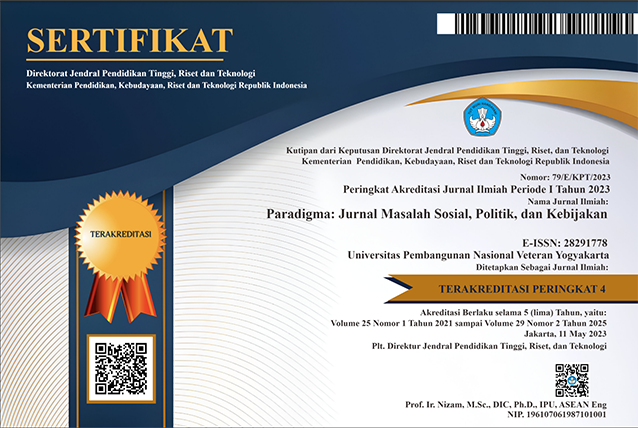Fashion Ekologis di Yogyakarta: Membangun Brand Awareness melalui Keterkaitan Diri dan Produk
DOI:
https://doi.org/10.31315/paradigma.v28i1.11422Keywords:
Self-Congruity, lurik, sustainable fashion, the small and medium-sized fashion enterprise (SME)Abstract
This study delves into the brand communication strategy and the implementation of sustainability values in the small and medium-sized fashion enterprise (SME), Lori Lurik, highlighting its success in amalgamating brand identity, sustainability, and communication strategies to foster personal and emotional connections with its consumers. Grounded in the Self-congruity Theory and the Message Planning Model, Lori Lurik consistently opts for handwoven lurik fabric as its primary material, reflecting local and cultural values. Following the principles of self-congruity, Lori Lurik successfully builds brand awareness through compelling narratives on Instagram and engaging consumers in interactive quizzes. Design innovations, such as the distinctive asymmetrical features, provide differentiation in the competitive fashion industry. The utilization of leftover production materials and a zero-waste packaging strategy underscores the commitment to sustainability, while challenges in leveraging influencers serve as crucial considerations for enhancing brand awareness. This research contributes practical insights for similar SMEs, emphasizing the importance of integrating sustainability values and communication strategies to strengthen brand images in dynamic markets.
References
Aaker, Alexander David. 2012. Building Strong Brands. New York: The Free Press.
Bajari, Atwar. 2022. Perencanaan Pesan Dan Media. Bandung: Universitas Padjajaran.
Berger, Charles R. 2015. “Planning Theory.” In The International Encyclopedia of Interpersonal Communication, Wiley, 1–9.
Defitri, Mita. 2022. “Sustainable Fashion Brand Di Indonesia.” https://waste4change.com/blog/brand-tekstil-sustainable-di-indonesia/.
Erianti, Vivi Dwi. 2023. “Peran Self-Congruity Dan Brand Image Dalam Memediasi Pengaruh Brand Personality Terhadap Brand Love (Studi Pada Konsumen Coffeeshop Praketa Purwokerto).” Thesis. Universitas Jenderal Soedirman.
Junaedi, Didi. 2019. “The Influence Od Self-Congruity and Mobile Marketing on Brand Loyalty at Fast Food Restaurants California Chicken in Subang City.” Diskursus Ilmu Manajemen STIESA (Dimensia) 16(2). www.topbrand-award.com.
Kang, Juhee, Liang Tang, and Ju Yup Lee. 2013. “Self-Congruity and Functional Congruity in Brand Loyalty.” Journal of Hospitality & Tourism Research 39(1): 105–31.
Kozlowski, Bardecki, and Searcy. 2019. “Tools for Sustainable Fashion Design: An Analysis of Their Fitness for Purpose.” Sustainability 11(13): 3581.
Kulsum, Umi. 2020. “Sustainable Fashion as The Early Awakening of the Clothing Industry Post Corona Pandemic A R T I C L E I N F O Umi Kulsum 1 / Sustainable Fashion Awal Kebangkitan Industri Busana Pasca Pandemi Corona.” International Journal of Social Science and Business 4(3): 422–29. https://ejournal.undiksha.ac.id/index.php/IJSSB/index.
Moleong, Lexy J. 2018. Metodologi Penelitian Kualitatif / Penulis, Prof. DR. Lexy J. Moleong, M.A. Cetakan ke-38. Bandung: PT Remaja Rosdakarya,.
P. Smith. 2022. Sustainable Fashion Worldwide - Statistics & Facts.
Pramarsudhi, Savitri Abshari, Riky Azharyandi Siswanto, and Ganjar Gumilar. 2021. “Perancangan Identitas Visual Dan Media Promosi Gerakan Sosial Sustainable Fashion Di Indonesia Visual Identity Design and Promotional Media of Indonesia’s Sustainable Fashion Movement.” In Bandung.
Rijali, Ahmad. 2019. “Analisis Data Kualitatif.” Alhadharah: Jurnal Ilmu Dakwah 17(33): 81.
Ruiz, Arabella. 2023. “47 Official Sustainable Fashion Statistics.” https://theroundup.org/sustainable-fashion-statistics/.
Sirgy, M. Joseph. 2018. “Self-Congruity Theory in Consumer Behavior: A Little History.” Journal of Global Scholars of Marketing Science 28(2): 197–207.
Sirgy, M.Joseph. 1985. “Using Self-Congruity and Ideal Congruity to Predict Purchase Motivation.” Journal of Business Research 13(3): 195–206.
Sutantio, Maradita. 2021. “Fashion Sebagai Perlawanan Dan Media Komunikasi.” JURNAL RUPA 5(2): 74.
WCED. 1987. World Commission on Environment and Development. Berlin.
Widjaja, Wachidin. 2009. Pengaruh Self-Congruity Terhadap Brand Loyalty Pada Pengguna Telepon Genggam Nokia Elny Widjaja (Marketing Manager, PT. Sony Indonesia, Broadcast and Professional Products Division).
Zafar, Md et al. 2015. “Sustainable and Ethical Fashion: The Environmental and Morality Issues.” IOSR Journal Of Humanities And Social Science (IOSR-JHSS 20(8): 17. www.iosrjournals.org.
Downloads
Published
How to Cite
Issue
Section
License
The manuscript submitted to Paradigma: Jurnal Masalah Sosial, Politik, dan Kebijakan journals are released under the license of Creative Commons Attribution-Non Commercial- ShareAlike (CC BY SA) if and when the article is accepted for publication.
We declare that:
- This paper has not been published in the same form elsewhere.
- It will not be submitted anywhere else for publication prior to acceptance/rejection by this Journal.
- A copyright permission is obtained for materials published elsewhere and which require this permission for reproduction.
Retained Rights/Terms and Conditions
Authors retain all proprietary rights to the published works, such as (but not limited to) the following rights:
- Copyright and other proprietary rights relating to the article, such as patent rights,
- The right to use the substance of the article in own future works, including lectures and books,
- The right to reproduce the article for own purposes,
- The right to self-archive the article
The right to enter into separate, additional contractual arrangements for the non-exclusive distribution of the article's published version (e.g., post it to an institutional repository or publish it in a book), with an acknowledgment of its initial publication in this journal Paradigma: Jurnal Masalah Sosial, Politik, dan Kebijakan



